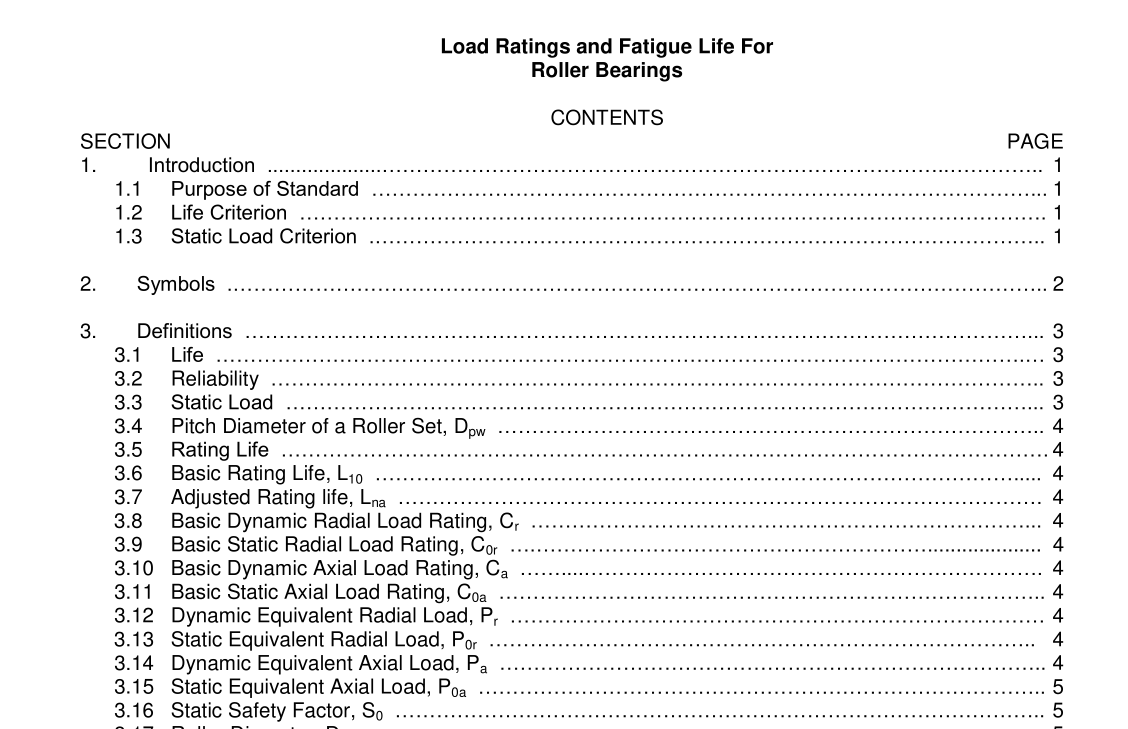ABMA 11:2014 pdf download.Load Ratings and Fatigue Life for Roller Bearings ANSI/ABMA 11:2014
1.1 Purpose of Standard
Roller bearing performance is a function of many variables. These include the bearing design, the characteristics of the material from which the bearings are made, the way in which they are manufactured, as well as many variables associated with their application. The only sure way to establish the satisfactory operation of a bearing selected for a specific application is by actual performance in the application. As this is often impractical, another basis is required to estimate the suitability of a particular bearing for a given application. This is the purpose of this standard. This standard specifies the method of calculating the basic dynamic load rating of rolling bearings within the size ranges shown in the relevant ANSI/ABMA standards, manufactured from contemporary, commonly used, good quality hardened bearing steel in accordance with good manufacturing practice and basically of conventional design as regards the shape of rolling contact surfaces. This standard also specifies the method of calculating the basic rating life, which is the life associated with 90% reliability, with commonly used high quality material, good manufacturing quality and with conventional operating conditions. In addition, it specifies the method of calculating adjusted rating life, in which various reliabilities, special bearing properties and specific operating conditions are taken into account by means of life adjustment factors. Furthermore, this standard specifies the method of calculating the basic static load rating and the static equivalent load for roller bearings within the size ranges shown in the relevant ANSI/ABMA Standards, manufactured from good quality hardened bearing steel, in accordance with good manufacturing practice and basically of conventional design as regards the shape of rolling contact surfaces.
1.2 Life Criterion
Even if roller bearings are properly mounted, adequately lubricated, protected from foreign matter, and are not subjected to extreme operating conditions, they can ultimately fatigue. Under ideal conditions, the repeated stresses developed in the contact areas between the roller and the raceways eventually can result in fatigue of the material which manifests itself as spalling of the load carrying surfaces. In most applications the fatigue life is the maximum useful life of a bearing. This fatigue is the criterion of life used as the basis for the first part of this standard. Fatigue life calculated in accordance with this standard does not represent the maximum that can be attained by applying all known technology to roller bearing design and application. Neither does it represent the minimum that should be expected of a bearing made by a producer lacking skill and experience in the design and manufacture of roller bearings, even though the bearing meets the geometric parameters given below. The calculated fatigue life represents the performance normally expected from high quality bearings made by reputable manufacturers. Manufacturers can supply longer lived bearings by the application of advanced materials and manufacturing processes. The present standard has evolved as a means for bearing users to specify a reasonable standard of performance for the bearing they wish to purchase.
1.3 Static Load Criterion
A static load is a load acting on a non-rotating bearing. Permanent deformations appear in rollers and raceways under a static load of moderate magnitude and increase gradually with increasing load. It is often impractical to establish whether the deformations appearing in a bearing in a specific application are permissible by testing the bearing in that application. Other methods are therefore required to establish the suitability of the bearing selected.
ABMA 11:2014 pdf download
